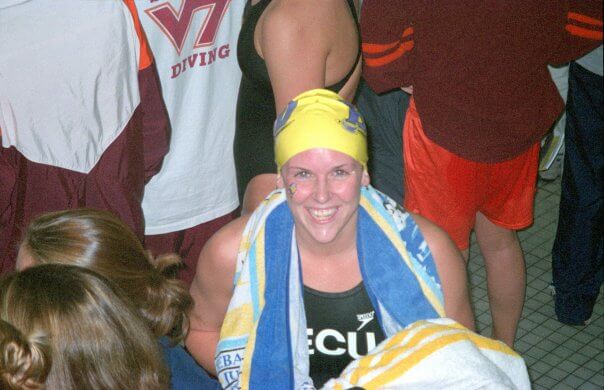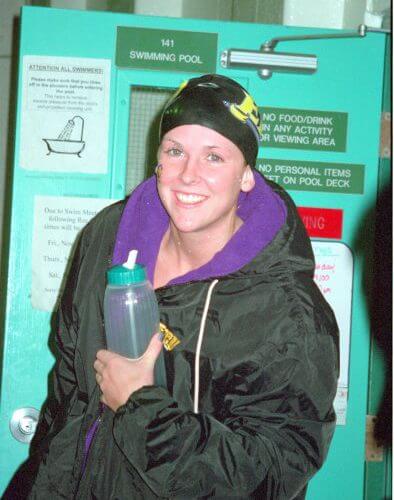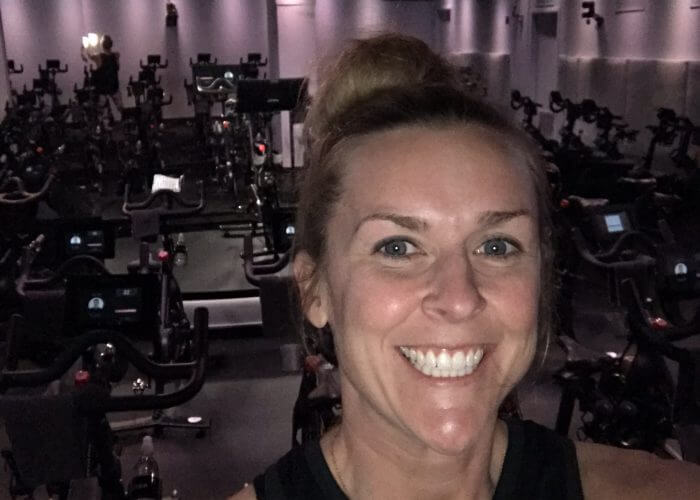Sam Perry: Blood Clots — The Biggest Drag on My Swimming Career

By Sam Perry, Swimming World Contributor
I’ve been a swimmer my whole life — I grew up competing in the York Swim Club of Potomac Valley (PVS) under coach Greg York, and participated in junior and senior nationals during high school. When I got to college at East Carolina University (ECU), I was a 100 and 200 meter breaststroker, and was a top breaststroker for the team during my freshman year and the beginning of my sophomore year.
Then one day at a swim meet, I felt a bad pain in my right leg and lower back as I climbed out of the pool. The pain was shocking, almost paralyzing. But it passed, and the next day I was in the pool again, pushing myself through more pain than usual. My breath wouldn’t come, my limbs felt sluggish and I put in one of the worst performances of my college athletic career.
I figured I had the flu or some other kind of bug, and kept practicing through the pain. The team doctor couldn’t find anything wrong with me, but after I saw him things got worse. I began coughing up blood, and couldn’t sleep.
After two weeks, I finally went to the emergency room. My right leg was swelling fast, and a CT scan quickly revealed an enormous blood clot that had been growing there for who knows how long. Back then, I had no idea the impact this blood clot would have on me and my swimming career.
Today I know all about blood clots, medically known as venous thromboembolism (VTE) because that experience when I was in college eventually led me to take a job with the International Society on Thrombosis and Haemostasis (ISTH) in North Carolina. I’m the Campaign Manager for World Thrombosis Day, which is observed globally every Oct. 13 to raise awareness of blood clots.
I also know now that VTE is a health risk for people like me who have a genetic variant called Factor V Leiden. That, along with being on a hormonal birth control pill, were two big risk factors that I wasn’t aware of. Factor V Leiden makes it easier for blood to coagulate, increasing the chances of developing a dangerous clot in a blood vessel. It’s especially common to get them in the deep veins of the leg, where they can break off and be pumped through the circulatory system to the lungs. That’s why I was coughing up blood and gasping for breath in the pool. I had both a deep vein thrombosis (DVT) and a pulmonary embolism (PE). Together, DVT and PE are known as VTE — a dangerous and potentially deadly medical condition.

Photo Courtesy: Sam Perry
First, the doctors tried a drug called recombinant urokinase to break up the clot. When that didn’t work, they surgically took out as much of the clot as they could. I still have four inches of blocked vein in my right leg.
After I got out of the hospital, I remember sitting in the shower shaving my legs — because I was too weak to stand — and feeling sure my swimming career was over. I was devastated. I essentially had to relearn how to walk, mostly by doing laps around the ECU track. I felt like a person four times my age.
I was out on a medical red shirt for the remainder of my sophomore season due to the clot, but as soon as I could, I got back in the pool. I had to take blood thinners and wear a support stocking to keep blood from pooling in my leg — I swam with it throughout every practice and was fitted for a special stocking to wear during meets. It fit under my suit, but it was thick and probably created some drag.
During my junior year I was unable to participate in any dry land activity because it was too much stress on my leg. But I could swim and I could walk. I worked hard to regain my stamina, and swam well enough during my last year at ECU to be nationally ranked (28th after the Nike Cup in Chapel Hill, NC in the 200 meter breaststroke). I even finished third in the conference championship my junior year and finished second my senior year.
Now it’s been 21 years since that first blood clot. I had a second clot about 10 years after the first, and that convinced me to do everything I could to prevent another. I’m on blood-thinning drugs for life, and wear my support stocking everywhere. But I don’t let it stop me from running marathons, teaching cycling classes, and scuba diving. If anything, I figure the exercise helps prevent another clot by keeping my blood flowing. I’ve finished three marathons and one triathlon.
Having a life-threatening medical crisis at age 19 didn’t just feel like the end of my college swimming career—it made me feel like my life had ended before it could even begin.
But through it all, I’ve managed to say fit and relatively healthy. I’m in pain every day, but I’m thankful that I can still be active. Over the years, I’ve come to realize that setbacks like the ones I went through are just that — temporary obstacles in the pursuit of progress. Most of the time, if you approach an injury or illness with the same determination and dedication you give to swimming, you can bounce back.

Photo Courtesy: Sam Perry



